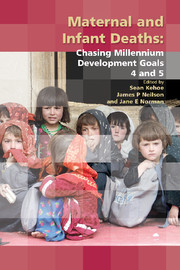Book contents
- Frontmatter
- Contents
- Participants
- Declaration of personal interests
- Preface
- The Millennium Development Goals
- SECTION 1 THE SIZE OF THE PROBLEM
- SECTION 2 CLINICAL PROBLEMS AND SOLUTIONS – MATERNAL
- 5 Postpartum haemorrhage
- 6 Reducing deaths from hypertensive disorders of pregnancy
- 7 Obstructed labour (including partograms)
- 8 Puerperal sepsis in low- and middle-income settings: past, present and future
- 9 Unsafe abortion and strategies to reduce its impact on women's lives
- 10 HIV and tuberculosis
- 11 A pragmatic approach to safe anaesthesia
- SECTION 3 CLINICAL PROBLEMS AND SOLUTIONS – NEONATAL
- SECTION 4 TRAINING AND DEVELOPMENT
- SECTION 5 SPECIFIC CHALLENGES IN SPECIFIC COUNTRIES
- SECTION 6 CONSENSUS VIEWS
- Index
10 - HIV and tuberculosis
from SECTION 2 - CLINICAL PROBLEMS AND SOLUTIONS – MATERNAL
Published online by Cambridge University Press: 05 February 2014
- Frontmatter
- Contents
- Participants
- Declaration of personal interests
- Preface
- The Millennium Development Goals
- SECTION 1 THE SIZE OF THE PROBLEM
- SECTION 2 CLINICAL PROBLEMS AND SOLUTIONS – MATERNAL
- 5 Postpartum haemorrhage
- 6 Reducing deaths from hypertensive disorders of pregnancy
- 7 Obstructed labour (including partograms)
- 8 Puerperal sepsis in low- and middle-income settings: past, present and future
- 9 Unsafe abortion and strategies to reduce its impact on women's lives
- 10 HIV and tuberculosis
- 11 A pragmatic approach to safe anaesthesia
- SECTION 3 CLINICAL PROBLEMS AND SOLUTIONS – NEONATAL
- SECTION 4 TRAINING AND DEVELOPMENT
- SECTION 5 SPECIFIC CHALLENGES IN SPECIFIC COUNTRIES
- SECTION 6 CONSENSUS VIEWS
- Index
Summary
HIV, tuberculosis and the Millennium Development Goals
An estimated 33 million people worldwide were living with HIV at the end of 2007, almost half of whom were women, with 2.7 million new HIV infections and 2 million HIV-related deaths in that year. Two-thirds of people living with HIV are in sub-Saharan Africa, where around 60% of infections are in women, and where 75% of AIDS-related deaths occur. The southern African sub-region is the most severely affected, where 35% of the global HIV infections and 38% of AIDS deaths occurred in 2007. Worldwide, 45% of the estimated 2.7 million new infections annually occur in young people aged 15—24 years, an age group in which young girls are particularly susceptible to infection and in which pregnancy is common. The number of children younger than 15 years living with HIV has continued to increase from 1.6 million in 2001 to 2.0 million in 2007. While new infections in children have shown some decline with increased access to strategies to prevent mother-to-child transmission, an estimated 370000 children younger than 15 years still became infected with HIV in 2007. This remains a predominantly African problem, with 90% of infections and over 90% of an estimated 270 000 HIV-related deaths in the region in 2007.
HIV is the strongest link between the Millennium Development Goals (MDGs) 4, 5 and 6. A response to the global HIV/AIDS pandemic is in itself a major component of the MDGs, with MDG 6 specifically addressing the HIV epidemic.
- Type
- Chapter
- Information
- Maternal and Infant DeathsChasing Millennium Development Goals 4 and 5, pp. 163 - 176Publisher: Cambridge University PressPrint publication year: 2010



